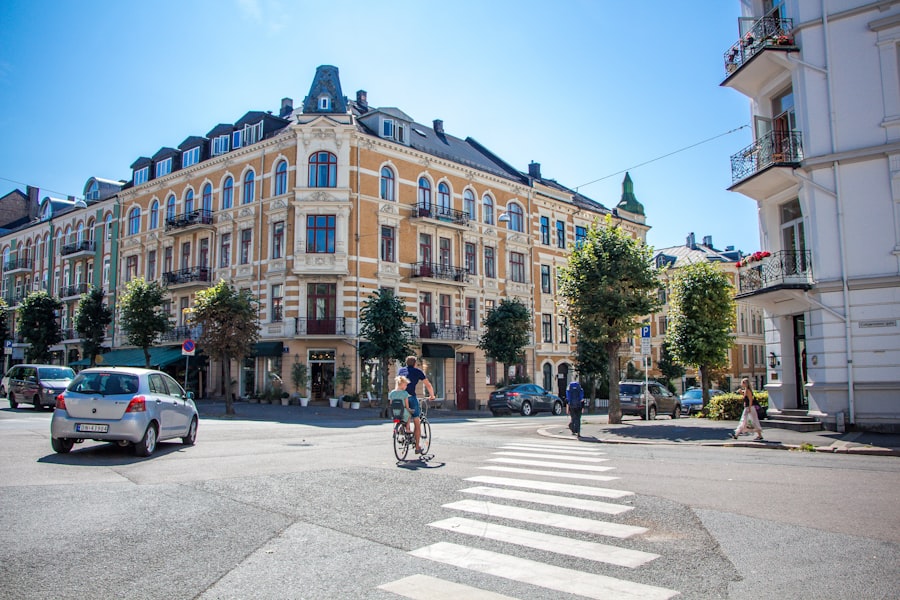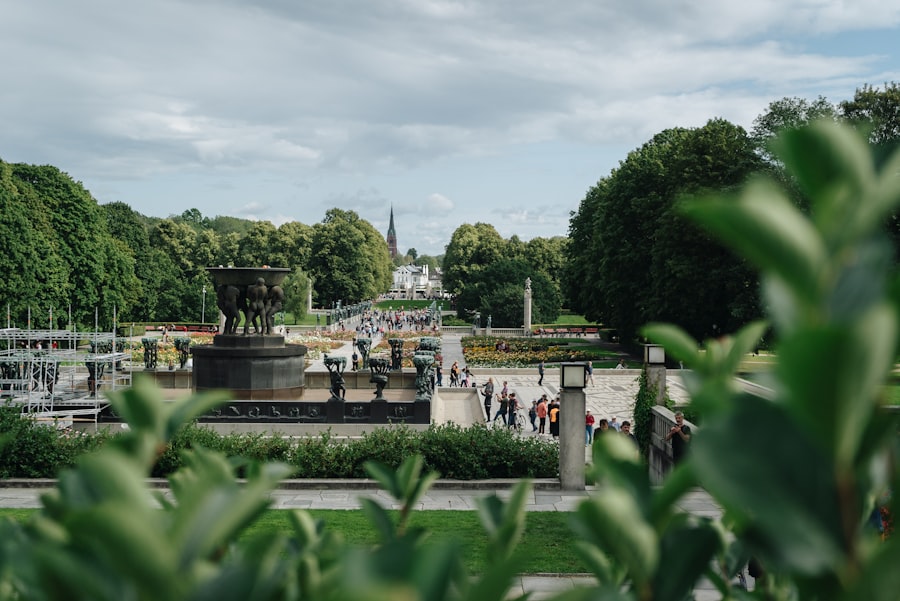In Norway, greetings are an essential part of social interaction, reflecting the country’s culture of politeness and respect. A simple “Hei” (Hi) is the most common way to greet someone, suitable for both casual and formal situations. When meeting someone for the first time, it is customary to shake hands while maintaining eye contact, which conveys sincerity and openness.
For a more formal greeting, one might say “God dag” (Good day), which is often used in professional settings or when addressing someone of higher status. Polite expressions are equally important in Norwegian culture. Phrases such as “Takk” (Thank you) and “Vær så snill” (Please) are frequently used and appreciated.
Norwegians value directness, but they also appreciate courtesy. Therefore, incorporating these expressions into your conversations will not only enhance your communication but also endear you to the locals. When parting ways, a friendly “Ha det bra” (Goodbye) or “Vi sees” (See you) is customary, leaving a positive impression as you conclude your interaction. Take the first step. Book a consultation with the Norway Relocation Group for your move to Norway.
Summary
- When in Norway, it’s important to greet people with a handshake and maintain eye contact as a sign of respect.
- Basic questions like “How are you?” and “What’s your name?” are commonly used to start conversations, and responses should be polite and friendly.
- When ordering food and drinks, it’s customary to say “please” and “thank you” and to wait for everyone to be served before starting to eat.
- Asking for directions politely and saying “excuse me” when approaching someone for help is considered good manners in Norway.
- Expressing gratitude is important, so remember to say “thank you” and “you’re welcome” when appropriate.
Basic Questions and Responses
Asking questions is a fundamental aspect of engaging with others, and in Norway, it is no different. Basic questions such as “Hva heter du?” (What is your name?) and “Hvordan har du det?” (How are you?) are excellent starting points for conversation. These inquiries not only show interest in the other person but also provide an opportunity to practice your language skills.
When responding, you can simply say “Jeg heter [Your Name]” (My name is [Your Name]) or “Jeg har det bra, takk” (I am well, thank you), which keeps the dialogue flowing. In addition to personal questions, it is useful to know how to ask about everyday topics. For instance, “Hvor er toalettet?” (Where is the toilet?) or “Hva tid er det?” (What time is it?) can be particularly helpful in various situations.
The ability to ask and respond to these basic questions will significantly enhance your confidence in navigating social interactions in Norway. Moreover, Norwegians are generally friendly and willing to help, so don’t hesitate to engage them with your queries.
Ordering Food and Drinks

When it comes to dining out in Norway, knowing how to order food and drinks can greatly enhance your experience. A typical phrase to use when ordering is “Jeg vil gjerne ha…” (I would like to have…), followed by the name of the dish or drink you desire. For example, if you wish to order a traditional dish like “fårikål” (lamb and cabbage stew), you would say, “Jeg vil gjerne ha fårikål.” It’s also polite to add “Takk” at the end of your order to express gratitude.
Understanding the menu can sometimes be a challenge due to the variety of local dishes. Familiarising yourself with common food items such as “brød” (bread), “ost” (cheese), and “kaffe” (coffee) will make ordering much easier. Additionally, if you have dietary restrictions or preferences, it’s helpful to know how to communicate these.
Phrases like “Jeg er vegetarianer” (I am a vegetarian) or “Jeg har allergi mot nøtter” (I am allergic to nuts) will ensure that your dining experience is both enjoyable and safe.
Asking for Directions
Navigating a new city can be daunting, but knowing how to ask for directions can alleviate much of that stress. In Norway, a simple way to ask for directions is by saying “Unnskyld, kan du hjelpe meg?” (Excuse me, can you help me?). This polite approach often encourages locals to assist you enthusiastically.
Once you have their attention, you can specify your destination by saying something like “Hvor ligger [destination]?” (Where is [destination]?). When receiving directions, it’s important to listen carefully and take notes if necessary. Common terms that may come up include “venstre” (left), “høyre” (right), and “rett fram” (straight ahead).
Additionally, phrases like “Er det langt?” (Is it far?) can help clarify how much time you might need to reach your destination. Norwegians are generally helpful and will often go out of their way to ensure you find your way.
Expressing Gratitude
Expressing gratitude is a vital part of social interactions in Norway. The phrase “Takk for hjelpen” (Thank you for your help) is particularly appreciated when someone has gone out of their way to assist you. Whether it’s a friend who has helped you with directions or a waiter who has provided excellent service, acknowledging their efforts with gratitude fosters goodwill and strengthens relationships.
In addition to verbal expressions of thanks, small gestures can also convey appreciation. A smile or a nod can go a long way in showing that you value someone’s assistance. If you feel particularly grateful, consider saying “Jeg setter stor pris på det” (I really appreciate it).
This deeper expression of gratitude can leave a lasting impression and encourage positive interactions in the future.
Common Courtesies and Manners

Understanding common courtesies and manners is essential when interacting with Norwegians. One key aspect of Norwegian etiquette is punctuality; being on time is highly valued in both social and professional settings. Arriving late can be seen as disrespectful, so it’s advisable to plan accordingly.
If you do find yourself running late, a quick message or call to inform the other party is considered courteous. Another important aspect of manners in Norway is respecting personal space. Norwegians tend to maintain a comfortable distance during conversations, especially with those they do not know well.
It’s also customary to wait for everyone to be served before starting a meal; this shows respect for others at the table. By adhering to these social norms, you will demonstrate an understanding of Norwegian culture and foster positive relationships with those around you.
Talking about the Weather
The weather is a popular topic of conversation in Norway, often serving as an icebreaker in social situations. Given the country’s varied climate, discussing the weather can lead to engaging dialogues about personal experiences and preferences. A simple phrase like “Hvordan er været i dag?” (How is the weather today?) can initiate such discussions.
Norwegians are accustomed to discussing everything from sunny days to snowy winters, so don’t hesitate to share your thoughts on the weather conditions. You might say something like “Det er kaldt i dag” (It is cold today) or “Det ser ut som det blir sol” (It looks like it will be sunny). This shared interest in weather not only provides common ground but also allows for deeper conversations about outdoor activities and seasonal traditions.
Making Small Talk
Small talk is an integral part of socialising in Norway, helping to build rapport and ease into more meaningful conversations. Topics such as hobbies, travel experiences, or local events are excellent starting points for small talk. You might begin with a question like “Hva liker du å gjøre på fritiden?” (What do you like to do in your free time?), which invites the other person to share their interests.
Additionally, discussing recent events or cultural happenings can also serve as effective small talk topics. For instance, mentioning an upcoming festival or concert can spark enthusiasm and lead to further discussion about music or arts in Norway. Remember that Norwegians appreciate authenticity; being genuine in your conversations will resonate well with them and foster connections.
Understanding Common Norwegian Signs and Instructions
When navigating through Norway, understanding common signs and instructions can significantly enhance your experience. Familiarising yourself with basic vocabulary related to signs will help you feel more confident while exploring the country. For example, signs indicating “Utgang” (Exit) or “Inngang” (Entrance) are essential for finding your way around buildings.
Moreover, public transport signs often include terms like “Buss” (Bus), “Tog” (Train), and “Stopp” (Stop). Being able to read these signs will not only assist you in getting from one place to another but also help you understand local customs related to transportation. If you’re ever unsure about a sign’s meaning, don’t hesitate to ask locals for clarification; they will likely appreciate your effort to engage with their language.
Using Public Transportation
Public transportation in Norway is efficient and widely used by both locals and tourists alike. Knowing how to navigate this system can greatly enhance your travel experience. When using buses or trains, it’s helpful to understand phrases such as “Hvor kan jeg kjøpe billetter?” (Where can I buy tickets?) or “Hvilken linje går til [destination]?” (Which line goes to [destination]?).
Once on board, it’s important to be aware of local customs regarding seating and behaviour. For instance, offering your seat to elderly passengers or those with disabilities is considered polite. Additionally, keeping noise levels down and refraining from eating strong-smelling foods are common courtesies that contribute to a pleasant atmosphere for all passengers.
Navigating Social Situations and Events
Navigating social situations in Norway requires an understanding of local customs and behaviours. When attending events such as parties or gatherings, it’s customary to greet everyone upon arrival with a friendly handshake or smile. Bringing a small gift, such as flowers or chocolates, is also appreciated as a gesture of goodwill.
During conversations at social events, Norwegians often value authenticity over small talk; sharing personal stories or experiences can lead to deeper connections. However, be mindful of sensitive topics; discussions about politics or personal finances may be considered inappropriate until a closer relationship has been established. By being respectful of these social norms and engaging genuinely with others, you will find yourself welcomed into Norwegian society.
As you embark on your journey into the Norwegian language and culture, consider enrolling in courses at the NLS Norwegian Language School in Oslo. Their comprehensive curriculum offers tailored lessons that cater to various proficiency levels, ensuring that you gain confidence in speaking Norwegian while immersing yourself in the rich cultural context of the language. With experienced instructors guiding you through practical scenarios—such as greetings, ordering food, or navigating public transport—you’ll find yourself well-prepared for real-life interactions in Norway.
Embrace this opportunity at NLS Norwegian Language School; it’s an invaluable step towards mastering the language and enhancing your experience in this beautiful country!
Learn more about the Norwegian classes at the NLS Norwegian Language School in Oslo

